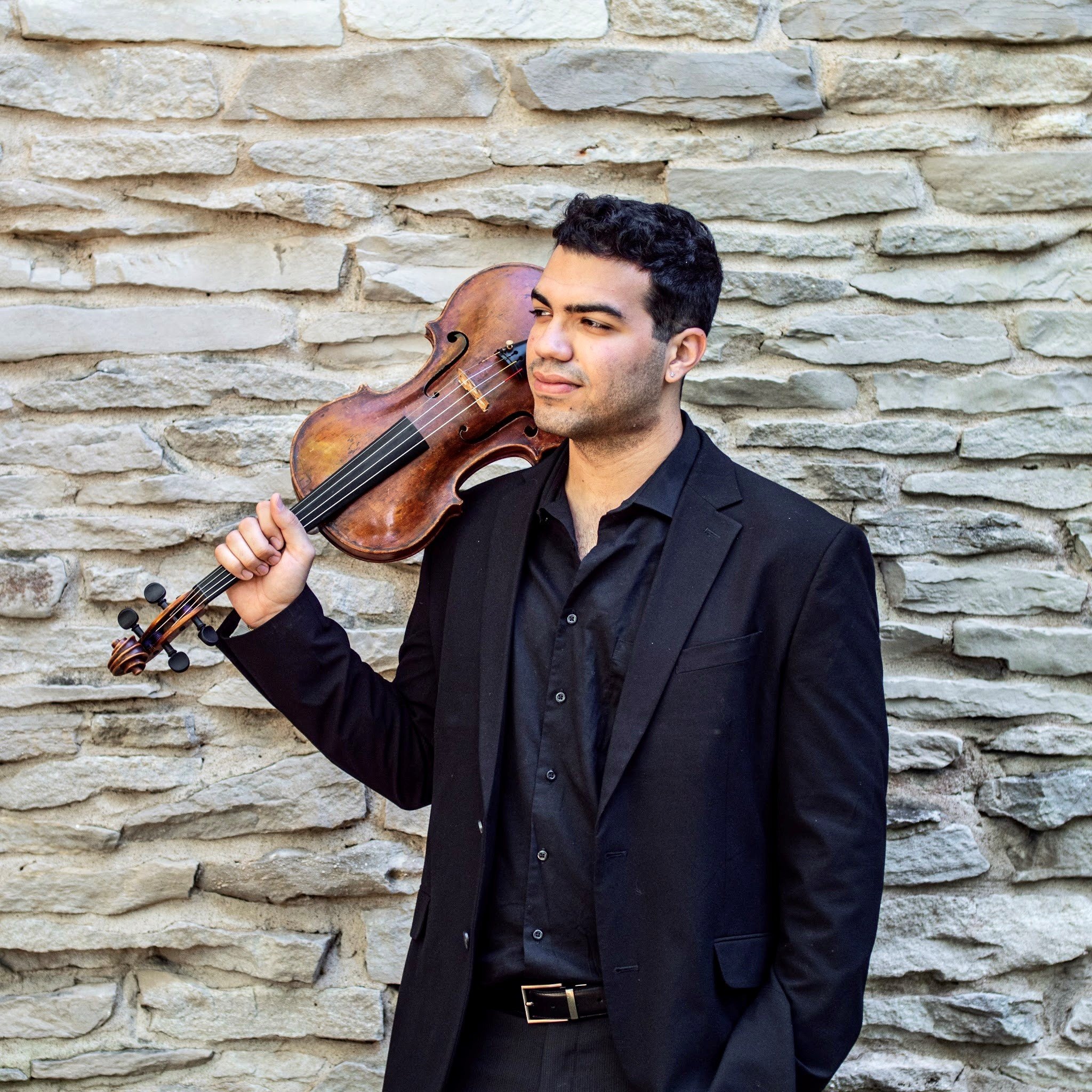Sounds of Cinema Program Notes
Conducted by Maestro Lowell Graham
Saturday, May 18th, 2024 | 7 PM
Union Colony Civic Center
A native of Salvador, Brazil, violinist/violist, Yuri Santos, is an active performer acclaimed for his versatility as an orchestral, recitalist, and chamber musician. He currently serves as co-concertmaster of the Greeley Philharmonic Orchestra, and violist of the Lírios Quartet. Yuri’s accolades include first prizes at the BeethovenHaus Bonn String Quartet Competition, Macauley Chamber Music Competition, South Florida Young Artist Solo Competition, and recipient of the Music Society of Coral Lakes and Edward H. Benenson awards. As a soloist he has appeared with the Bachiana Filarmônica Sesi-SP, Orquestra Antunes Câmara, and IU Conductor’s Orchestra.
Yuri has performed throughout the United States, Europe, and Brazil, collaborating with celebrated artists such as Jeremy Denk, Andrés Díaz, Peter Bruns, as well as the Calidore and Aeolus Quartets. He has attended numerous music festivals including the Music Academy, Britten-Pears Chamber Music, and Meadowmount School of Music, and has served the Kuttner String Quartet Residency at Indiana University, closely working with the Pacifica Quartet. As a member of the Lírios Quartet, he was recently named Emerging Artist Quartet in Residence at MacPhail Center for Music, with performances in Minneapolis, MN and Madeline Island, WI. Currently, Lírios is part of the graduate string quartet residency at the University of Colorado Boulder, under the mentorship of the Takács Quartet. Beginning his musical studies at the age of eight under the tutelage of his father, Ênio Antunes, Yuri has earned a Bachelor of Music and a Performer Diploma from Indiana University Jacobs School of Music as a student of Kevork Mardirossian, Mauricio Fuks, and Mark Holloway.
Soprano, Courtney Caston, was born and raised in Mableton, Georgia. In May 2019, Ms. Caston obtained her Master of Music degree in Vocal Performance from the University of Northern Colorado. Previous UNC Opera Theatre credits include Erste Dame in Die Zauberflöte and Agathe (Cover) in Der Freischütz. During the summer of 2019, she traveled to Germany to perform with the professional opera company, Opera Classica Europa. In Germany, she performed as the High Priestess in Aida and Erste Dame in Die Zauberflöte.
Ms. Caston has also performed with the Simpson College Opera Theatre, the Denver Young Artists Orchestra, the Atlanta Opera High School Institute, and The Boston Conservatory Vocal/Choral Intensive Summer Program. In 2018, she performed in a concert as the title role in Aida with the Denver Young Artists Orchestra. In 2017, Ms. Caston obtained her undergraduate Bachelor of Music degree in Vocal Performance from Simpson College. While attending Simpson College, she performed numerous roles for the Simpson College Opera Theatre. Her full roles include Countess Almaviva in The Marriage of Figaro, La Ciesca in Gianni Schicchi, Dido in Dido and Aeneas, and Giunone in La Calisto. Partial roles include Mimì in La Bohème, Donna Elvira in Don Giovanni, and Alice Ford in Falstaff. She also advanced to the finals of the Denver Lyric Opera Guild Competition in 2021, 2022, and 2023, where she placed in the top 10 each year. Ms. Caston is currently based in Denver, Colorado.
REPERTOIRE
La gazza ladra (The Thieving Magpie): Overture
Rossini was 25 when he wrote this opera; he was at the height of his powers and had already achieved recognition for having “reformed” opera nearly single-handedly. Of his quick rise, Rossini quipped, “I woke up one morning and found myself famous.” In the next few years he composed many more operas, over forty in all. Then, having become the most famous opera composer in the world— and making a fortune in the process—he abruptly laid down his pen and composed no more. While La gazza ladra has many comedic moments the focus of the opera is serious indeed. Rossini grabs the listener’s attention with a drum roll and military march for an introduction. The first of the major themes is introduced with a scintillating passage in the strings. The music continues with a succession of tunes from the opera, including a delightfully playful section for the woodwinds and some unusual—and splendid—writing for the trombones. Rossini caps it all off with a presto of high excitement and orchestral pizzazz.
- adapted from Mark Rohr
Violin Concerto No. 3 (7’)
The final movement of Mozart’s third violin concerto is interrupted by tempo and meter changes that give the movement a distinctive character. Although it begins with a rousing and jolly character, the music comes to an unexpected halt midway through and turns mysterious, characterized by pizzicato strings and a new theme played by the soloist. Suddenly the atmosphere swings again to introduce a lusty tune. Although the first slower tune does not relate to any known folk song, the second lusty tune is believed to correspond to a Hungarian dance that was identified in a collection as “the melody of Strasbourg,” giving way to the name “Strasbourg Concerto.”
- adapted from James M. Keller
Toccata and Fugue in D Minor (10’)
The many great organ works of Johann Sebastian Bach have been transcribed for countless instrumental ensembles in the two and a half centuries since his death. The legendary conductor, Leopold Stokowski, brought this practice to perhaps its zenith with his many powerful adaptations of Bach’s keyboard work for full symphony orchestra. The most famous of these is his transcription of Toccata and Fugue in D Minor, which was featured in the classic 1940 Disney film, Fantasia, and has since become ubiquitous in both the classical repertoire and in many different streams of popular culture worldwide. The Toccata is rhapsodic, like an improvisation, a feature which is relatively unusual for an organ work of its time. It has been suggested that Bach’s celebrated piece was not originally written for the organ, nor even in d-minor. It might have been written for violin or harpsichord, and some scholars believe it to be too crude a piece to have been written by Bach at all.
- adapted from Donald Hunsberger
Radetzky-March Op. 228 (4’)
Radetzky March is generally acclaimed as among the greatest of all pieces in the march vein. It was named for Johann Joseph Count Radetzky de Radetz, a venerable Austrian Field Marshal. It was commissioned by Field Marshall Lieutenant Peter Zanini, to celebrate Radetzky’s victories, primarily the Battle of Custoza. After the first performance, conducted in Vienna by the composer on August 31, 1848, the piece became the unofficial Austrian anthem along with the Blue Danube waltz. When it was first played for Austrian officers, they spontaneously clapped and stomped their feet during the chorus. This tradition, with a light rhythmic clapping during the first iteration of the melody followed by thunderous clapping during the second, is kept alive today by audience members who know of the custom when the march is played. It has been a long-standing tradition of the Vienna Philharmonic to conclude every New Year’s concert with the work.
- adapted from University of North Texas University Band
Pirates of the Caribbean: Dead Man’s Chest (8’)
Hans Zimmer is a German film score composer and music producer, who has composed music for over 100 films, including Hollywood blockbusters such as the Pirates of the Caribbean series, Gladiator, The Lion King, The Da Vinci Code, Angels & Demons and Sherlock Holmes. Zimmer was born in Frankfurt am Main, Germany and moved to London as a teenager. He spent the early part of his career in the United Kingdom before moving to the United States. He is the head of the film music division at DreamWorks studios, and works with other composers through the company which he founded, Remote Control Productions. His work is notable for integrating electronic music sounds with traditional orchestral arrangements.
- written by ClassicFM
Hungarian Dance No. 5 (3’)
In 1869, after years of playing his Hungarian Dances at the piano for friends, Brahms decided to have them published. He had started playing these pieces at parties and social gatherings, as long ago as the early 1850's, remembering the “Hungarian” style- the spirit and the sounds, the folklike melodies and the halting rhythms. The Hungarian Dances find Brahms at his most easygoing. They were, in a sense, his way of escaping through music to his favorite cafes, where he enjoyed leisurely hours listening to Romani bands. When the dances proved even more popular than he anticipated, he made further arrangements for solo piano. Eventually the urge to make full orchestral pieces of them proved irresistible. Brahms himself orchestrated dances 1, 3, and 10; his friend Antonín Dvořák’s orchestrated Nos. 17-21; and most of the rest have been orchestrated over time by various composers and arrangers.
- adapted from Philip Huscher
Beim Schlafengehen No. 3 from The Four Last Songs (6')
At the age of 83, the leisurely Strauss became inspired by lyric poems by Josef von Eichendorff and Hermann Hessem. This interest resulted in a set of songs known as Four Last Songs. Strauss poured the most fundamental aspects of his musical style into these songs — a rainbow of orchestral color, radiant lyricism, and a life-long love affair with the soprano voice. Death, parting, and loss were the themes. As he lay fatally ill from a series of heart attacks, he exclaimed, "Dying is as I had composed it." The English translation of the third song, “Going to Sleep”, is as follows: “Now that I am wearied of the day, my ardent desire shall happily receive the starry night like a sleepy child. Hands, stop all your work. Brow, forget all your thinking. All my senses now yearn to sink into slumber. And my unfettered soul wishes to soar up freely into night's magic sphere to live there deeply and thousandfold."
- program notes by Dr. Stefan Errante
Adagio for Strings, Op. 11 (9’)
Samuel Barber’s moving Adagio for Strings is one of the most popular and frequently programmed American compositions in the standard repertoire. Elemental and beautiful, the Adagio has qualities that are rarely found together: a spacious, quintessentially American sound, but also a melancholy, ruminative mood that offers both insight and solace to the listener. Today, it is almost always turned to when American orchestras seek a musical work to provide beauty, solace and inspiration for their audiences. Its spiritual dimension was recognized in November 1963, after President John F. Kennedy’s assassination, when hundreds of ensembles spontaneously chose to play the Adagio in tribute; in the days following 9/11, this happened again. The Adagio is revered not only for its sensual appeal, but also for the way it seems to evoke a prayerful feeling of solemn contemplation and inspiration.
- adapted from Michael Clive
Star Wars: The Force Awakens (5’)
John Williams has become one of America’s most accomplished and successful composers for film and for the concert stage. He has composed the music for more than 100 films, including the Star Wars films, the first three Harry Potter films, and Home Alone. His 45- year artistic partnership with director Steven Spielberg has resulted in many of Hollywood’s most acclaimed and successful films. Mr. Williams has received five Academy Awards and 51 nominations, seven British Academy Awards, 24 Grammys, four Golden Globes, and five Emmys. In 2005, he received the Olympic Order for his contributions to the Olympic Movement. In 2004, he received Kennedy Center Honors, and in 2009 he received the National Medal of Arts, the highest award given to artists by the U.S. Government. In 2016, he received the 44th Life Achievement Award from the American Film Institute - the first time a composer was honored with the award.
- adapted from John Williams


